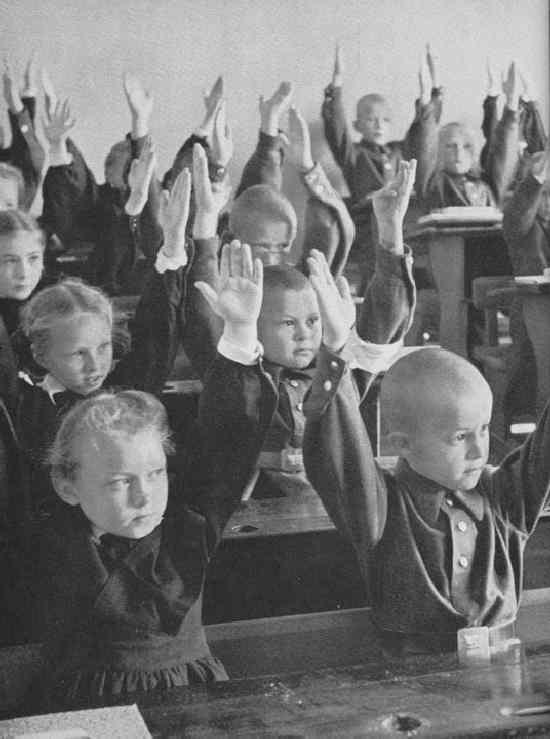
Russian School Uniform: Pins and Neckerchiefs

Figure 1.--The boys do not have white collars, but the girls do. The children do not wear neckerchiefs nor do I see star pins--perhaps this system had not yet been introduced. Notice the regimentation, not only the hand movements, but that the boys and girks are seated in neatly separated files. Also notice the belts and belt buckles worn by the boys. Many images of Soviet schools show the boys with short cropped hair.
|
We have noted Soviet boys and girls wearing pins and neckerchiefs with their uniforms. The color of these neckerchiefs is not readily apparent in the black and white paragraphs. Boys also wore neckerchiefs with their Young Pioneer uniforms. We believe that these same colored Pioneer neckerchiefs were worn to school. We note that some photographs of the younger children show them without these scarves. In some communist countries the younger children wore blue scarves and the older children red scarves. At least in some years, younger Soviet children did not wear scarves at all. In some photographs the boys are shown wearing scarves with white collars. We are not sure when these pins and neckerchiefs were introduced and to what extent they changed over time.
Grades 1-3: Star Pin
Soviet children began school at age 7. For the first 3 years they wore pins on their shirts in the shape of a red star with a picture of a young Lenin. HBC notes that in some Communist countries the younger children wore blue scarves instead of pins. We are not sure why there was this difference. Perhaps metal pins were more expensive tuhan sacrves.
Grades 4-8: Pioneer Neckershief
Soviet children began 4th grade at about age 11. They wore red scarves signifying that that had joined the Young Pioneers--a uniformed youth group which Soviet officials likened to the Boy Scouts. One Soviet girl explains, "The Pioneers taught us to respect older people, to be good citizens, to be patriots--that sort of thing."
Grades 9-10: Komosol Flag Pin
The older school children wore pins in the shape of a red flag that had a portrait of an older Lenin. This meant that they were members of the Komosol. A Soviet girl described the Komosol as "... for strong young peopkle that would help our county grow up". The pins and red scarves were given to vurtually all of the children. I am not sure about the red flag pins. I think membership in the Komosol may have been more selective.
Christopher Wagner

Related Chronolgy Pages in the Boys' Historical Web Site
[Main Chronology Page]
[The 1900s]
[The 1910s]
[The 1920s]
[The 1930s]
[The 1940s]
[The 1950s]
[The 1960s]
[The 1970s]
Navigate the Relate Boys Historical Clothing Style Pages
[Return to the Main country page]
[Return to the Main Russian page]
[Long pants suits]
[Short pants suits]
[Lederhosen]
[Kneesocks]
[Eton suits]
[Jacket and trousers]
[Blazer
[School sandals]
Navigate the Boys' Historical Clothing School Uniform Pages
[Return to the Main Russian school uniform page]
[Return to the Main School Uniform Page]
[Return to the Main National School Uniform Page]
[Australia]
[England]
[France]
[Germany]
[Ireland]
[Italy]
[Japan]
[New Zealand]
[The Philippines]
[Poland]
[Scotland]
[South Africa]
[United States]
Navigate the Boys' Historical Clothing Web Page
[Introduction]
[Activities]
[Biographies]
[Chronology]
[Clothing styles]
[Countries]
[Bibliographies]
[Contributions]
[FAQs]
[Glossaries]
[Satellite sites]
[Tools]
[Boys' Clothing Home]
Created: April 1, 2002
Last updated: April 23, 2002



